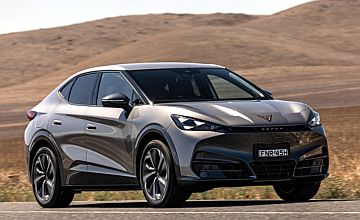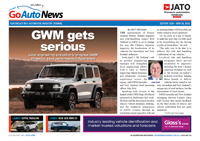OptionsCar reviews - Cupra - TavascanCupra modelsOverviewWe like Adequate power in all variants; attractive entry price; comfortable seats; good interior ergonomics; usable real-world range; Endurance’s spirited cornering ability; VZ’s compliant ride Room for improvement Endurance’s firm ride; VZ’s additional feeling of mass; light specification on entry variant; no online connectivity or companion app; reasonably expensive in dual-motor formats Spirited dynamics and adequate power headline the arrival of the Cupra Tavascan26 Mar 2025 By TOM BAKER Overview
A PANDEMIC, supply shortages, and belated introduction of a vehicle emissions penalty regime meant it has taken many years for the Volkswagen Group (VAG) line of mainstream electric vehicles to reach Australia – and now an onslaught of models based on the MEB modular architecture is landing effectively all at once.
Part of the challenge for the four local VAG marques – Volkswagen, Audi, Skoda, and Cupra – is to demonstrate distinctiveness in MEB products. On the face of it, it’s a tall order when battery size, power and torque levels are standardised, and the majority of the electric newcomers are midsize SUVs of similar dimension.
For Cupra, the performance offshoot of Spain’s Seat and newest VAG brand, the course is settled. Brand leaders used the local introduction of the Cupra Tavascan mid-size SUV (from $60,990 plus on-road costs) to reinforce that while the EV bona fides are shared with the Volkswagen ID.5 and Skoda Enyaq, the calling cards of Cupra are focussed ride and handling, and emotional design, regardless of fuel type.
Those characteristics have been proven out by most Cupra releases to date, particularly the hot Leon and Formentor (petrol/hybrid) and electric Born hatch, which arrived in Australia as a local MEB test case in 2023. Extending those attributes to the largest, heaviest Cupra to date in the Tavascan is a taller order.
Cupra newcomers may be tempted to give the Tavascan a look thanks to sharper-than-expected pricing. Endurance variants are well-powered by a 210kW/545Nm rear motor albeit with just-sufficient equipment; most takers will option an Interior Package (+$4500) adding heated, powered front seats, premium audio, 360-degree parking camera, and 20-inch wheels.
More performance can be had via the VZ grade ($74,490 +ORC) that includes the Interior Package and adds a front motor producing 80kW/134Nm. Max power is 250kW, while specification grows with adaptive dampers, 21-inch wheels, uprated tyres, Matrix LED headlights, and a fixed glass roof with power sunblind.
Soon, an Ultimate Pack (+$8000) will be selectable for the VZ bringing sticker-still tyres, Nappa leather trim, and Cup Racing front seats.
All permutations of Tavascan utilise the same 77.0kWh (usable) nickel manganese cobalt battery. Consumption for the Endurance (RWD) variants is rated at 14.4kWh/100km for 534km range, while the VZ (AWD) is marginally thirstier with a 15.4kWh/100km rating (499km range). Charging for both drivelines peaks at 135kW while a 10-80 per cent rapid-charging session averages 120kW to replenish 373km (RWD) or 349km (AWD) in 28 minutes.
A five-year/unlimited-kilometre vehicle warranty is standard with the traction battery warranted for eight years/160,000km. Scheduled maintenance takes place every two years/30,000km, with six year and 10-year service plans able to be rolled into the purchase price for $1310 and $2190 respectively.
As well as the refreshed Tesla Model Y (from $58,900 +ORC), other rivals to the coupe-roofline Tavascan include, among others, the Skoda Enyaq Sportline ($69,990 +ORC) and a mooted Volkswagen ID.5 Pro (TBC), along with the Kia EV6 GT-Line and BYD Sealion 7 Premium.
Driving Impressions
With Cupra’s high claims regarding the Tavascan’s driving dynamics in the back of our mind, we embarked on a revealing first drive of this SUV across a ‘greatest hits’ setlist of Adelaide Hills routes, as well as urban roads in the South Australian capital.
The extensive loop included significant drive-time in the three Tavascan specifications: a standard Endurance (riding on passive dampers, with staggered 255/50 R19 rear and 235/55 R19 front tyres), the Endurance with Interior Package (passive dampers, moving up to 255/45 R20 Continental tyres all-round), and the VZ (which gains 15-stage adaptive dampers).
Beneath dramatic sheetmetal the Tavascan utilises a MacPherson strut front suspension design and a multi-link independent rear suspension. A relatively efficient and powerful 210kW/545Nm rear motor is common, as well as dominant in the dual-motor VZ in which the aft engine provides 72 per cent of thrust.
Initial acceleration is strong in both models and the Endurance will be brisk enough for most.
The 6.8 second 0-100km/h claim partially reveals how push tails off towards triple figures, but the swifter VZ (5.5 sec) feels stronger at all street-legal speeds. However, no Tavascan yet feels powerful enough to fully exploit the capably rigid MEB platform and we think there’s room for a VZx.
A column-mounted direction selector allows a blunt choice between ‘D’ and ‘B’ modes with the latter enabling strong regeneration (but not true one-pedal drive). Steering-wheel mounted paddle shifters customise decelerative force when lifting the throttle in ‘D’ – we found our sweet setting right in the middle but when you need more braking force, the traditional pedal has awkwardly long travel before mushy (but ultimately effective) response is delivered.
There are clear differences in ride and handling, and therefore character, between the Endurance and VZ specifications that mean each will suit a different buyer. It is the Endurance (with or without Interior Package) that feels the more focussed of the pair – starting with marginally lighter tare mass (2238kg plays 2284kg) with most of the savings found over the front axle.
Both specifications share an attractive perforated leather steering wheel (admittedly beset by easily-bumped capacitive touch shortcuts), but response from the progressive-ratio electric power steering is crisper and more immediate in the Endurance, particularly when optioned with the Interior Package given the more zealous turn-in from its lower-profile alloys in 20-inch rubber.
Keener Endurance drivers will particularly enjoy their Tavascan’s propensity to tuck its nose into corner apices rapidly, resisting understeer quite well while the body remains remarkably flat. Driving out of corners reveals a fairly neutral balance unless ESC Sport is activated, which slackens the reins and allows substantial and controllable angle adjustment on throttle.
Part of this capability has been enabled by a firm setting for the passive dampers of the Endurance, with the front springs feeling particularly stiff. The ride borders on terse at low speeds across poor surfaces but compliance settles down considerably on the highway or on faster country roads.
Still, a back-to-back drive makes plain how much better the VZ rides, mostly on account of fitment of considerably upgraded dampers fitted with VAG’s dual-valved Dynamic Chassis Control Plus technology allowing 15 stages of stiffness adjustment. Compliance dramatically differs between comfort and sport indents and the driver can even push past these settings for extra softness or firmness.
Some will also enjoy the fact that the VZ is obviously faster in a straight line, but the dual-motor Tavascan stops short of feeling like the Goldilocks variant when corners are encountered. It still turns cleanly and handles well, but the additional front-end mass is evident, and understeer is that much easier to find while feeling less clearly rear-driven.
At least buyers can make a distinct selection between focussed but very firm with the Endurance, or fast and compliant, but a touch more distant, with the VZ. The forthcoming VZ Ultimate Package (adding even lower-profile sticky tyres and 21-inch alloys) could be interesting, but then you will be spending about $85,000 drive-away on what is best regarded as an upper-mainstream product.
In our view, we did not come away from the initial drive with a particular sweet spot, although if pushed we will ultimately choose the VZ as its ride makes it easier to live with every day if you have an urban commute on broken Australian tarmac.
Impressive in both models was refinement, with low levels of noise, vibration and harshness. Insulation from motor whine was evident by its near-absence while road noise is low, even on coarse surfaces, all the better to enjoy the well above average 12-speaker Sennheiser stereo specified with the Interior Package and beyond, with its Immersive mode particularly suiting live song recordings.
Frustrating steering wheel buttons (slowly being removed from VAG cars) aside, all Tavascan specifications also demonstrate an interior fit out that is logical and made from materials that are at times plush, and even when they are cast from cheaper plastics they usually feature interesting 3D-printed textures which lifts perceived expense.
Their fabric material is pleasant but an oversight at this price is the fitment of manual front seats to the base Endurance variant, making for time-consuming adjustments if the car is shared by a couple. The convenience of power-adjustable seats with memory (and in blue microfibre) for driver and passenger in the Interior Package, in addition to the Sennheiser’s clarity, by themselves justify much of the +$4500 upcharge.
Cabin ergonomics are impressive with a mid-set seating position allowing good visibility while still letting the driver feel like they are ‘in’ rather than ‘on’ the vehicle, and the reach/rake-adjustable wheel falls conveniently to hand. The standard-fit 13.0-inch touchscreen is bright with high resolution, and we found the wireless Apple CarPlay and Android Connections faultless.
We remain indifferent to the much smaller 5.3-inch driver’s instrument binnacle fitted to most MEB products (although noticeably not to the Tavascan-sized Audi Q4) which always displays speed and scrolls otherwise between limited next-direction, trip computer and adaptive safety views. And it remains a shame that Cupra (like other VAG brands in Australia) still does not have a full-featured, app-driven connectivity solution like so many rival brands.
Though the Tavascan’s 2766mm wheelbase is not especially lengthy for a vehicle based on a dedicated EV platform, rear seat space is generous enough for long-legged six-footers for both headroom and kneeroom, while USB-C ports and air vents are fitted, though door skins shift from pliant to hard as one moves from first to second row. Boot space is solid at 540 litres behind a power tailgate, though like nearly all full EVs, no spare wheel is fitted.
A quieter area (literally, as it turned out) that Cupra and other VAG brands intend to stand out in Australia is in the subtler tuning of their standard-fit adaptive safety technologies than what is witnessed during contemporary road tests of many other vehicles.
For instance, Cupra deactivates beeping speed limit warnings for Australia (even though they are required in Europe) while the Tavascan is not fitted with driver eye monitoring for Australia. Still, the adaptive cruise control and strong lane centring technology (that combine in a Travel Assist mode) were accurate, and the latter could be deactivated rapidly through a touchscreen shortcut.
Our electricity consumption climbed as we transitioned up the range with larger wheel/tyre sizes and extra power reducing efficiency. Across a hilly route, the un-optioned Endurance was the most miserly (17.0kWh/100km for 452km range) with the Interior Package’s 20-inch wheels contributing to 18.0kWh/100km (427km) while we recorded 20.0kWh/100km in the dual-motor VZ (385km).
As a comprehensive range of VAG vehicles based on the MEB architecture arrive in Australia, distinctions are rapidly becoming clearer between Group brands. All are reasonably quick, refined and efficient; so far, we are particularly impressed by the Skoda Enyaq, which demonstrates a particularly adept blend of control and compliance. The Audi Q4 adds a little more polish.
That Cupra has struck out in a firmer and more focussed direction for the Tavascan suits the car’s values, though the overall result is ultimately slightly less well-rounded on typical Australian roads. As for the Volkswagen parent brand itself? GoAuto drives the ID.4 and ID.5 on Australian roads shortly.
 |
OptionsClick to share
|














Facebook Twitter Instagram